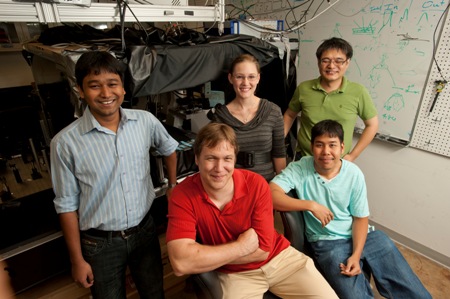A research team led by Stephan Link of Rice University Laboratory has found a method to manipulate light dispersed by gold nanorods utilizing liquid crystals. This method paves the way to fabricate metamaterials with unique optical properties, which can be manipulated actively.
 Rice University scientists have developed a method to control light scattering from nanoparticles using liquid crystals. Credit: Jeff Fitlow/Rice University
Rice University scientists have developed a method to control light scattering from nanoparticles using liquid crystals. Credit: Jeff Fitlow/Rice University
The arrangement of the liquid crystal molecules, which obstruct and expose the light scattered from the nanoparticles, are manipulated delicately by utilizing voltage. The findings of the study were published in Nano Letters, a journal of the American Chemical Society.
Stephan Link stated that his research team spent two years to identify the point, at which the light scattered from the nanoparticles can be fully controlled. The in-plane revolution of liquid crystal molecules sheathing every gold nanoparticle that functions as optical antennas is the basis of their method, he said. The novel device used by the research team is an upgraded version of a normal device that modifies the light polarization, he said.
The research team believes that its novel equipment can control the light transmitted from any nanostructure such as carbon nanotubes and quantum dots. During the study, the research team put nanorods that were randomly deposited on a glass slide between a series of alternating electrodes and added a cover slip and liquid crystal bath. A polyimide coating over the top cover slip directed the liquid crystals to arrange themselves in such a way, which is parallel to the electrodes.
Liquid crystals in the homogenous phase obstructed light transmitted from nanorods pointed one way, while allowing light from nanorods turned another way via a polarizer to the detector. During the application of a voltage of 4 V to the electrodes, liquid crystals moved towards the area of the nanorods that arranged themselves parallel with the electrical field of the electrodes, while crystal over the electrodes stayed together due to the cover slip coating. The crystals’ new structure is known as a twisted nematic phase.
Controlling light from nanorods
Link believes that his novel technique has great prospect when utilized with an arrangement of nanoparticles oriented in particular directions, where every nanoparticle can be fully controlled, like a switch.